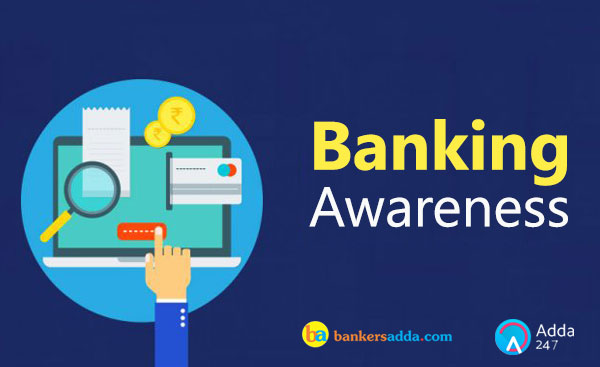(a) नगदी अंत:क्षेप
(b) नगदी अवशोषित
(c) बैंकिंग प्रणाली के साथ तरलता में वृद्धि
(d) तरलता को एक स्तर पर रखने के लिए
(e) दिए गए विकल्पों में से कोई भी सत्य नहीं है
S1. Ans.(b)
Sol. Repo operations therefore inject liquidity into the system. Reverse repo operation is when RBI borrows money from banks by lending securities. The interest rate paid by RBI is in this case is called the reverse repo rate. Reverse repo operation therefore absorbs the liquidity in the system.
Q2. आरबीआई के साथ बैंकों को रखने के लिए कैश रिजर्व का अनुपात आवश्यक है-
(a) नगदी अनुपात
(b) एसएलआर
(c) सीआरआर
(d) शुद्ध मांग और समय देयता
(e) दिए गए विकल्पों में से कोई भी सत्य नहीं है
S2. Ans.(c)
Sol. Cash Reserve Ratio (CRR) is the amount of funds that the banks have to keep with the RBI.
Q3. अर्धोपाय शब्द किसे संदर्भित करता है-
(a) वाणिज्यिक बैंकों द्वारा डीआरआई योजना के तहत अनुमत अग्रिम
(b) बीस प्वाइंट आर्थिक कार्यक्रम के तहत वाणिज्यिक बैंकों द्वारा अनुमोदित अग्रिम
(c) व्यय और राजस्व की रसीदों के प्रवाह के बीच अंतराल को जोड़ने के लिए सरकार को अपने बैंकरों द्वारा अस्थायी अनुमोदन दिया गया
(d) ऊपरोक्त सभी
(e) दिए गए विकल्पों में से कोई भी सत्य नहीं है
S3. Ans.(d)
Sol. All of the above
Q4. बैंक द्वारा अपने मुख्य / प्रमुख और प्राथमिक ग्राहकों पर लगायी गयी ब्याज की दरों को लोकप्रिय रूप से क्या कहा जाता है-
(a) जोखिम प्रीमियम
(b) न्यूनतम उधार दर
(c) रेपो दर
(d) रिवर्स रेपो दर
(e) फंड की लागत
S4. Ans.(b)
Sol. The interest rate charged by banks to their largest, most secure, and most creditworthy customers on short-term loans. This rate is used as a guide for computing interest rates for other borrowers.
Q5. रेपो दर क्या है?
(a) यह एक दर है जिस पर आरबीआई बैंकों को सरकारी प्रतिभूतियां बेचता है
(b) आरबीआई से उनके अधिशेष सरकारी प्रतिभूतियों को बेचकर आरबीआई से बैंक जिस कीमत पर उधार लेता है
(c) यह एक दर है जिस पर आरबीआई बाजार में छोटे ऋण की अनुमति देता है
(d) यह एक दर है जो बैंकों द्वारा उनके सबसे मूल्यवान ग्राहकों या प्रमुख ग्राहकों को प्रदान की जाती है
(e) दिए गए विकल्पों में से कोई भी सत्य नहीं है
S5. Ans.(b)
Sol. The rate at which banks borrow money from the RBI by selling their surplus government securities to RBI is known as “Repo Rate.
Q6. ‘बीएसआर’ शब्द का अर्थ है-
(a) बैंक की बिक्री दर
(b) मूल सांख्यिकीय विवरणियाँ
(c) प्राथमिकता क्षेत्र की अग्रिम के संबंध में आरबीआई को बैंकों द्वारा वार्षिक रिटर्न प्रस्तुत किया गया
(d) कृषि की प्रगति के लिए त्रैमासिक विवरण
(e) दिए गए विकल्पों में से कोई भी सत्य नहीं है
S6. Ans.(b)
Sol. Basic Statistical Return (BSR) System. The BSR system was introduced in December 1972 following the recommendation of the Committee on Banking Statistics adapting from the erstwhile data reporting system called Uniform Balance Book (UBB).
Q7. एक रुपया नोट के पर हस्ताक्षर होते हैं-
(a) भारतीय रिजर्व बैंक के गवर्नर
(b) भारत के प्रधान मंत्री
(c) भारत के राष्ट्रपति
(d) सचिव, वित्त मंत्रालय (भारत सरकार)
(e) दिए गए विकल्पों में से कोई भी सत्य नहीं है
S7. Ans.(d)
Sol. The One Rupee note is issued by Ministry of Finance and it bears the signatures of Finance Secretary, while other notes bear the signature of Governor RBI.
Q8. भारत में नोट जारी करने के प्रणाली निर्भर है-
(a) सोना जमा प्रणाली
(b) न्यूनतम रिजर्व प्रणाली
(c) आनुपातिक रिजर्व प्रणाली
(d) सरल जमा प्रणाली
(e) दिए गए विकल्पों में से कोई भी सत्य नहीं है
S8. Ans.(b)
Sol. Initially, the proportional reserve system was adopted in India. Later on, India adopted the minimum reserve system and is still continuing with this system of note issue. The entire issue of currency notes is subjected to the regulations framed in the RBI Act, 1935.
Q9. भारतीय रुपया है-
(a) अधिमूल्यित सिक्का
(b) मानक अधिमूल्यित सिक्का
(c) मानक सिक्का
(d) सोने का सिक्का
(e) दिए गए विकल्पों में से कोई भी सत्य नहीं है
S9. Ans.(b)
Sol. Indian rupee coin is a mixture of the standard coin and the token coin. Like standard money, Indian rupee is of unlimited tender. Like token money it’s face value exceeds its intrinsic value.
Q10. भारतीय रिजर्व बैंक द्वारा जारी किए गए मुद्रित नोट———–के हस्ताक्षर के तहत जारी किए जाते हैं-
(a) कार्यकारी निदेशक
(b) उप राज्यपाल
(c) राज्यपाल
(d) सचिव
(e) दिए गए विकल्पों में से कोई भी सत्य नहीं है
S10. Ans.(c)
Sol. The currency notes are issued by the Reserve Bank of India under the signature of Governor of RBI.
Q11. 1969 में भारतीय रिजर्व बैंक द्वारा भारत सरकार के परामर्श से निम्नलिखित में से कौन सा संस्थान स्थापित किया गया था, जो बैंक प्रबंधन में अनुसंधान, प्रशिक्षण, शिक्षा और परामर्श के लिए एक स्वायत्त शीर्ष संस्था के रूप में था?
(a) बैंकर ट्रेनिंग कॉलेज, बॉम्बे
(b) कॉलेज ऑफ एग्रीकल्चरल बैंकिंग, पुणे
(c) राष्ट्रीय बैंक प्रबंध संस्थान
(d) उपर्युक्त सभी
(e) दिए गए विकल्पों में से कोई भी सत्य नहीं है
S11. Ans.(c)
Sol. National Institute of Bank Management (NIBM) was established in 1969 by the Reserve Bank of India, in consultation with the Government of India, as an autonomous apex institution for research, training, education and consultancy in bank management. Its mandate is to play a proactive role of “think-tank” of the banking system. NIBM is part of the grand vision of giving a new direction to the banking industry in India and making the industry a more cost-effective instrument for national development.
Q12. अवसाद की अवधि में जब रिजर्व बैंक बैंकिंग प्रणाली को और अधिक साख बनाने के लिए प्रोत्साहित करना चाहता है तो-
(a) बैंक दर कम कर देता है
(b) बैंक दर बढ़ाता है
(c) बाजार की ताकत से बैंक दर तय करने की अनुमति देता है
(d) उपर्युक्त सभी
(e) दिए गए विकल्पों में से कोई भी सत्य नहीं है
S12. Ans.(a)
Sol. When Bank Rate is increased by RBI, the borrowing costs of the banks increase which, in return, reduce the supply of money in the market. Additionally, when the unemployment rate within a country increases, the central bank decreases the bank rate so that individuals can get loan at a reduced rate.
Q13. साख के नियामक के रूप में अपने कर्तव्यों के प्रदर्शन के लिए, भारतीय रिजर्व बैंक के पास सामान्य साख नियंत्रण के सामान्य साधन होते हैं, जैसे-?
(a) बैंक दर
(b) खुला बाजार संचालन
(c) बैंकों की आरक्षित आवश्यकता को बदलने की शक्ति
(d) उपर्युक्त सभी
(e) दिए गए विकल्पों में से कोई भी सत्य नहीं है
S13. Ans.(d)
Sol. All of the above.
Q14. जब रिजर्व बैंक साख के विस्तार को सीमित करना चाहता है-
(a) बैंक दर बढ़ाता है
(b) बैंक दर कम कर देता है
(c) बैंक दर स्थिर कर देता है
(d) दिए गए विकल्पों में से कोई भी सत्य नहीं है
(e) उपर्युक्त सभी
S14. Ans.(a)
Sol. When Bank Rate is increased by RBI, the borrowing costs of the banks increase which, in return, reduce the supply of money in the market. Additionally, when the unemployment rate within a country increases, the central bank decreases the bank rate so that individuals can get loan at a reduced rate.
Q15. आरबीआई द्वारा जारी मुद्रा नोटों में शत प्रतिशत सम्मिलित है-
(a) अनुमोदित संपत्तियां
(b) सोना
(c) विदेशी मुद्रा
(d) न्यासीप्रतिभूतियां
(e) दिए गए विकल्पों में से कोई भी सत्य नहीं है
S15. Ans.(a)
Sol. Reserve Bank notes have a cent per cent cover in approved assets. There is no ceiling on the amount of notes that can be issued by the Bank at any time. According to Section 33 of the RBI Act, the assets of the Issue Department against which currency notes are issued have to consist of gold coin and bullion, foreign securities, rupee coin.














